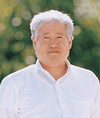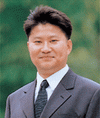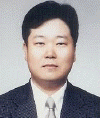School of Civil and Environmental Engineering
Civil Engineering occupies a prominent
position as one of the major fields in the
engineering profession
Educate civil and environmental engineers adaptable to the changing environment
The objectives of civil and environmental engineering are to provide public welfare and to meet the demand of human and socioeconomic activities by developing nature. Civil and environmental engineering deals with the planning, construction, and management of infrastructures, like multi-purpose dam, highway, bridge, tunnel, subway, skyscraper, artificial island, rapid transit railway, harbor, airport, urban design, regional development, etc. and to predict and solve environmental problems.
This program started from 1974 as the Department of Civil Engineering and now there are four tracks, structural engineering, geotechnical engineering, water resources engineering, and environmental engineering in the School of Civil and Environmental Engineering. The educational objectives of this program are to educate, global leaders who can detect and adapt themselves to the global trends, engineers with intelligence and good human nature in charge of the construction of infrastructure, and experts who pursue the harmony between human and nature and suggest desirable direction for national development. This program is almost the top 10 among the universities in Korea. Most alumni are working in a major construction or engineering company, public agency, and research institute.

- Seoul National Univ., B.S.
- Seoul National Univ., M.S.
- Lehigh Univ., Ph.D.
- Structural Engineering
dbbae@kookmin.ac.kr

- Seoul National Univ., B.S.
- Seoul National Univ., M.S.
- Cornell Univ., Ph.D.
- Geotechnical Engineering
njcho@kookmin.ac.kr

- Seoul National Univ., B.S.
- Seoul National Univ., M.S.
- Northwestern Univ., Ph.D.
- Concrete Engineering
shchoi@kookmin.ac.kr

- Seoul National Univ., B.S.
- Seoul National Univ., M.S.
- Univ. of California at Berkeley, Ph.D.
- Structural Engineering
kjhong@kookmin.ac.kr

- Seoul National Univ., B.S.
- KAIST, M.S.
- Kyoto Univ., Ph.D.
- Environmental Engineering
kimdh@kookmin.ac.kr

- Seoul National Univ., B.S.
- Seoul National Univ., M.S.
- Georgia Institute of Technology, Ph.D.
- Geotechnical Engineering
geotech@kookmin.ac.kr

- Seoul National Univ., B.S.
- Seoul National Univ., M.S.
- Univ. of Liverpool, Ph.D.
- Coastal Engineering
hkim@kookmin.ac.kr

- Seoul National Univ., B.S.
- Seoul National Univ., M.S.
- Seoul National Univ., Ph.D.
- Environmental Engineering
sanghlee@kookmin.ac.kr

- Kookmin Univ., B.S.
- Kookmin Univ., M.S.
- Oregon State Univ., M.S.
- Oregon State Univ., Ph.D.
- Structural Engineering
leeyou@kookmin.ac.kr

- Seoul National Univ., B.S.
- Seoul National Univ., M.S.
- California Institute of Technology, Ph. D.
- Structural Engineering
ockoogi@kookmin.ac.kr

- Seoul National Univ., B.S.
- Univ. of Colorado, M.S.
- Univ. of Colorado, Ph.D.
- Environmental Engineering
jinsiksohn@kookmin.ac.kr

- Seoul National Univ., B.S.
- Seoul National Univ., M.S.
- Univ. of California at Berkeley, Ph.D.
- Hydrology and Hydraulics
jyang@kookmin.ac.kr
Basic Courses
Engineering Mechanics (3)Composition and resolution of forces, equivalent force systems, equilibrium of particles and rigid bodies, centroids and centers of gravity, analysis of simple structure, friction, and method of virtual work.
Engineering Mathematics Ⅱ (3)This course is continued from Engineering MathematicsⅠ, and it covers sequences and series, approximation and errors, solution of equations by iteration, interpolation, numerical integration and differentiation, numerical methods in linear algebra, numerical methods for differential equations.
Application of computational method (3)Application of computation software to solve problems in civil engineering.
Introduction to Engineering Design (3)Developing ability for creative engineering design by utilizing engineering knowledge.
Mechanics of Materials (3)The strength and elasticity of materials, the theory of stresses and strains,deformation of beams and shafts, torsion, and buckling of columns.
Structural Analysis I (3)This course includes the elastic analysis of statically determinate frames and trusses, and calculations of deflections by the method of moment area and virtual ork, etc.
Soil Mechanics I (3)Fundamental chemical, physical, and mechanical properties affecting the engineering behavior of soil. Identification, classification, permeability, stresses, and stress analysis of soil. Consolidation, stress.strain behavior, and shear strength.
Fluid Mechanics (3)This subject is composed of basic mechanics which describe the motion of fluid and hydrostatics. These are prerequisites of hydraulics, hydrology and coastal engineering.
Environmental Science (3)This course covers aquatic chemistry and microbiology. Topics include the characterization and analysis of organic and inorganic constituents in water and wastewater, the chemical reaction, as well as the characteristics and metabolism of microorganisms.
Probability and Statistics (2)This subject deals with various probabilistic methods and statistic methods which are useful for the analysis of experimental data sets, including basic concepts of theories and pplications.
Civil Engineering Design (3)An intensive study of one or more areas of civil and environmental engineering, with emphasis on engineering design and application. Major Courses
Surveying (3)For a complete survey the students are required to practise field surveying on a regular basis and to present the results in the classroom. Planning and design of surveys adoption of specifications and coordinate system and of a proper datum, selection of equipment. Care, handling and adjustment of instruments. Selection of computational procedures and methods for date presentation and for recording data. Relationship between angles and distances. Adjustment of survey measurements. Mapping and map drafting.
Hydraulics Ⅰ (3)This course is composed of basic fluid mechanics, open channel hydraulics, and pipe flow mechanics. These topics will lead to riverhydraulics and water supply engineering.
Water Supply Engineering (3)Water quality standards and regulations. An overview of water treatment plants, design of unit operations, predesign of water treatment plants, hydraulics of plants, process control, and cost estimation.
Environmental Ecology (2)An overview of the transformation and destruction of environmental ecology by pollution, proper controls, and solutions to minimize ecological damage. Basic principle of ecosystem, influences upon ecosystem by pollution of environment and by destruction of natural sites. Variation and destruction of ecosystem by industrialization and civilization.
Design of Reinforced Concrete Structures Ⅰ (3)Mechanical and structural characteristics of concrete and reinforcing steel will be studied at first in this course. The instant and time dependent behavior of concrete and fundamental structural behavior of various reinforced concrete sections will be studied closely. And then reinforced concrete beams subjected to flexure, shear, and torsion will be designed based on ultimate strength design concept.
Structural Analysis Ⅱ (3)Analysis of statically indeterminate structures, methods of slope.deflection, and moment distribution. Influence lines for determinant and indeterminate structures.
Structural Laboratory Test (3)A study of the behavior of simple steel structural members and planning, testing and reporting. Aquisition, analysis, and presentation of experimental data.
Soil Mechanics Ⅱ (3)The application of theory and principles in engineering practice. An introduction to geotechnical engineering in practice slope stability, retaining structures, shallow and deep foundations, and soil improvement.
Soil Laboratory Test (1)Tests on the engineering properties of soils Atterberg limits, grain size analysis, specific gravity of soil solids, permeability, consolidation, direct.shear, CBR tests, etc.
Wastewater Engineering (3)Process design of wastewater treatment plants, including primary and secondary treatment, advanced treatment detailed design review of existing plants, process control, and economics.
Experiment in Hydraulics (1)This involves several applications of hydraulics with various empirical formulas. supported by laboratory scale experiments.
Hydraulics Ⅱ (3)This course involves several applications of hydraulics with various empirical formula, including wave theories, sediment transport, and unsteady open channel hydraulics.
Traffic Engineering (3)Traffic flow theories and their applications to traffic operation and control. Measurement of traffic variables. Deterministic and stochastic models of traffic flow and traffic phenomena. Capacity analysis of freeways and urban streets. Traffic signal optimization. Pedestrian movements. Accidents analysis. Parking regulation. Relationship between the provision of transportation services and the environment air, noise, energy, and the specific localized impacts associated with large scale construction.
Concrete Properties and Laboratory Test (3)Experiments will be conducted in order to understand the material behavior of concrete including creep, shrinkage, and mix design. Structural behavior will be studied with crack propagation observation, the bending test, and experimental methodology.
Foundation Engineering (3)The application of theories and the principles of soil mechanics to foundation design. Site investigations and engineering tests of evaluating subsoil conditions. Bearing capacity, stress distribution, and settlement. The design of shallow and deep foundations.
Design of Reinforced Concrete Structures II (3)This course continues after “Design of Reinforced Concrete Structures I”, and covers more profound and united knowledge about the design of reinforced concrete structural members such as continuous beams, frames, slabs, columns, footings, retaining walls, etc.
Design of Steel Structures (3)he design of steel structures including tension and compression members, frames, plate.girders, etc. Additional topics include connections, composite beams, and fatigue and fracture concepts related to structural design.
Hydrology (3)This subject covers understanding the water circulation system on the earth, ie. evaporation, rainfall, infiltration, and hydrologic phenomena, effective use of water resources, control of floods, and the analysis of measured data.
Physico.chemical Treatment (3)Fundamentals of physical and chemical reaction engineering, such as coagulation and flocculation, granular filtrations, sedimentation, carbon absorption, gas transfer and membrane processes, applications for advanced wastewater treatment, activated sludge process, fixed.film processes, aerobic and anaerobic digestion, and sludge disposal.
Environmental Experiments (1)Characterization and analysis of typical natural waters and wastewaters for inorganic and organic constituents. Selected experiments include solids, nitrogen species, oxygen demand, chlorine, alkalinity, pH, hardness, and trace analysis. Discussion of relevance of these measurements to water and wastewater engineering.
Computer Structural Analysis (3)Calculus of matrix, force, and displacement methods of structural analysis. Matrix analysis of frames and trusses. Includes computer analysis of sample structures.
Design of Prestressed Concrete Structures (3)The principles of prestressed concrete structures. Analysis and design of basic flexural members. Instantaneous and time.dependent properties of materials, prestress losses, etc.
Design of Earth Structures (3)Soil.structure interaction such as retaining structures, earth dams, and tunnels. Earth pressure theories. Design of rigid, flexible, braced, tied.back, slurry, and reinforced walls. Stability excavation, cut and natural slopes. The basic analysis and earthquake.proof design methods of earth structures.
Construction Management (3)Introduction to general civil engineering work. The fundamentals of construction planning the organization of construction sites, planning, scheduling, and cost estimation, bidding, the design of false work and shoring systems, and construction loadings. Optimization of construction processes.
Water Resources Design and Management (3)An introduction to the design of engineering structures which control and/or utilize runoff, emphasizing the sizing of structures to meet hydrologic uncertainity. Applies principles and techniques from several disciplines, including hydrology, hydraulics, probability and statistics. Specific techniques include flood frequency analysis risk analysis design storm techniques rainfall.runoff modeling.
Coastal Engineering (3)This includes the mechanics of waves, tides and tidal currents, as well as sediment transport, field measurement techniques, and the design of coastal structures.
Design of Water Supply Network and Treatment Plant (3)Topics include the fundamentals of treatment plant design, unit operation design, computer simulation of water supply network design,and a detailed design review of existing plants.
Bridge Design (3)Introducing the behavioral characteristics of various types of bridges such as the plate.girder bridge, arch bridge, suspension bridge, cable.stayed bridge, etc. Design team approach to the analysis and design of bridges in steel and reinforced concrete. Emphasis on the design of superstructures of bridges.
Advanced Structural Mechanics (3)Static and geometrical stability and the degree of statical indeterminacy. Application to energy methods such as virtual work, minimum total potential, etc. Additional topics include basic concepts of fracture mechanics and structural dynamics.
Geotechnical Design for Rail Roads and Highways (3)This course includes basic design concepts of ground survey, material characteristics of road.bed, traffic.load characteristics of railroads and motor vehicles, and road bed structure design for railroads and highways.
Harbor Design (3)This course is composed of a short review of coastal engineering, and design practice of harbor. Typical harbor structures are breakwaters, sea walls, and quays. Waterways should also be designed and managed properly. The structures are designed to be safe against tides, waves and tidal currents. Design practice is undertaken using numerical model packages, and CAD.
Water Pollution (3)Topics include the cause, damage, and possible solution of water resources pollution as well as reservoir management and operation sequencing and sizing of water resources projects. Emphasis on the management of water quality and protection from water pollution. Water uses, quality standards, various materials and its changes in water cycle. Causes, damages and possible solutions of pollution of major water resources such as rivers, lakes, and dams.
Design of Wastewater Treatment Plant (3)Topics include the fundamentals of wastewater treatment plant design, unit operation design, computer simulation of wastewater supply network design, and a detailed design review of existing plants.
Computer Programming (3)This course is aimed to study computer software and languages for application to various engineering problems. It includes fundamental usage of computer software as well as advanced functions such as programming,
Introduction to Overseas Construction Projects (3)This course covers the following topics to help the students to understand the overseas construction projects. Overview of the global constuction markets and the current situation of Korean construction industry, estimate of the cost of construction project in foreign countries, introduction to FIDIC, case history of the remarkable overseas construction projects, cultural and environmental characteristics of the major market areas, etc.
Plant Construction (3)The objective of this course is to provide general information on various plant including sea water desalination, wastewater reuse, water and wastewater treatment, and smart water gird. The engineering and construction of desalination plant is focused on this course. It mainly covers basic concept and design on desalination based on RO process. Pre-treatment and post-treatment of RO treatment are also covered.
Civil Engineering Mathematics (3)It defines and makes understanding a concept of the answer of important partial differential equation in engineering practice. It introduces one dimensional wave equation showing movement of a wave circle, two dimensional wave equation by a thin wave film and Laplace’s equation. Also, it introduces the solution by the Laplace’s conversion and Fourier’s conversion.
Construction English into practice (3)It trains technical terms as English in the specific situations from an early contract to completion of construction, conversation in daily business and technical details in pracitcal affairs for manpower to be added.
























